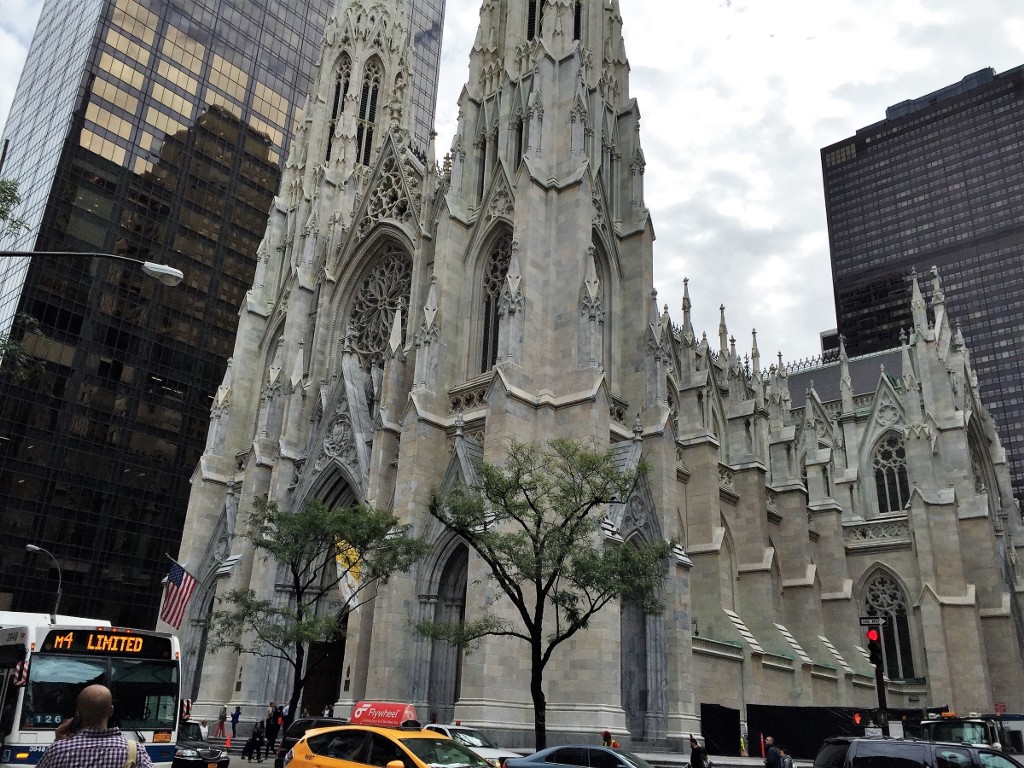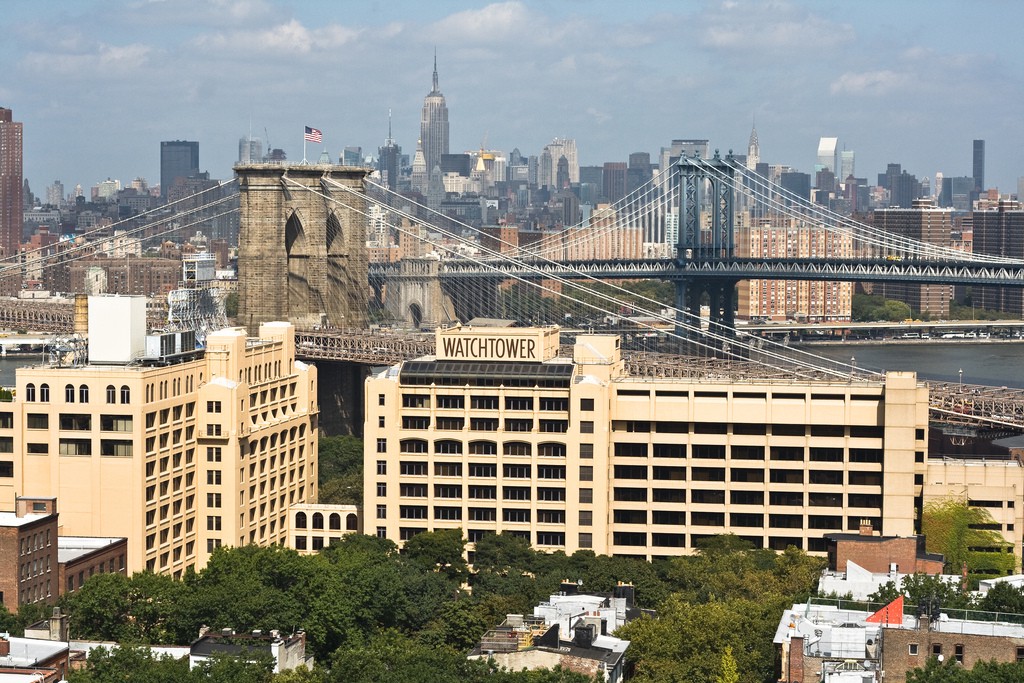God's Condos
by Brendan O’Connor

In midtown Manhattan on Tuesday, the main organ at the Cathedral of St. Patrick, the seat of the archbishop of the Roman Catholic Archdiocese of New York, Cardinal Timothy Dolan, was being tuned in preparation for a visit from the Bishop of Rome and Sovereign of Vatican City, Pope Francis. The eighty-five-year-old organ comprises seven thousand, eight hundred and fifty-five pipes, the shortest of which are less than an inch long and the longest of which, at thirty-two feet, are laid horizontally in the walls above the tourists’ and parishioners’ heads. A long, high note rang out before being joined by another, lower note. Tourists walked between the pews, eyes and iPhones rising to the ceiling as workers dismantled scaffolding and applied a dark brown finish to the carved wood rising around the main altar. Francis will be the fourth pontiff to visit the cathedral when he attends vespers, or evening prayer, on Thursday. His imminent presence has hastened the conclusion of a three-year, one-hundred-seventy-seven-million-dollar project to restore the structure to its original appearance.
Construction began on St. Patrick’s in 1858. After a pause for the Civil War, it opened in 1879 and, according to the New York Times, was consecrated in 1910, once it was free of debt. But by 2012, the white and gray marble of the facade had absorbed so much soot and dirt as to be indistinguishable from each other, and an inspection found about eighteen thousand areas needing repair. Inside, too, the cathedral — built as economically as possible — was falling apart. “If we don’t do something substantive for St. Patrick’s Cathedral, in four or five years we’re going to have to close it, because it will be dangerous,” Cardinal Dolan told the Times. “There is actually an exponential degradation of the building,” said Jeffrey Murphy, a partner in the architectural firm responsible for the renovation. “A little crack that would cost three hundred dollars to fix initially has the potential to turn into a several thousand dollar stone replacement if left unchecked. It’s not hyperbole to say that doing nothing will cause the archdiocese to spend a lot more money down the line.”
For all intents and purposes, the renovation, which was scheduled to be completed in December, is done. The sprawling gallery organ has been dismantled and reassembled after each pipe was cleaned individually, as were the cathedral’s nearly four thousand stained-glass panels. The ceiling’s original paint scheme has been restored. The sixteen-and-a-half-foot tall, five-and-a-half-foot wide, ninety-two-hundred-pound bronze doors were removed, repaired, and reinstalled. The project received thirty-seven million dollars in financing from the cathedral’s trustees and one hundred million from private benefactors, Kate Monaghan, a spokeswoman for the Roman Catholic Archdiocese of New York, told the Times. The rest of the hundred and seventy-seven million dollars is still being raised.
Elsewhere, though, all is not well in the archdiocese, which represents 2.8 million Catholics in three hundred sixty-eight parishes throughout Manhattan, the Bronx, Staten Island, Westchester County, and part of the Catskills. In November of last year, Cardinal Dolan announced that a hundred and twelve of those parishes would be merged to create fifty five new parishes, and that, in thirty-one of those new parishes, a church would be closed. (The Brooklyn Diocese, which includes Queens and claims a million-and-a-half million Catholics, reduced its total number of parishes to a hundred and eighty-even from a hundred and ninety-nine in 2009.) “Years of pastoral experience tell us that churches which are ten to twenty percent full do not usually lead to meaningful and uplifting liturgies where we are drawn to give praise and thanks to our loving God,” he said in a 2013 financial report. “And, apostolates and ministries of education, service, and charity — the ways within which we witness to the world — cannot flourish where there are not significant membership and resources to support them, so critical pastoral needs are not being met.” Basically, the church is downsizing.
Before November, forty-two parishes had been consolidated in New York since the mid-sixties, Dolan told the Times. But with falling attendance numbers — on average, only about fifteen percent of the archdiocese’s Catholics regularly attend Sunday Mass — and rising maintenance costs, more drastic measures were needed. In Dolan’s original announcement, he identified thirty churches that would be closed; in May, he identified seven more, leaving the archdiocese with two hundred and ninety-six parishes — twenty percent smaller than it was a year ago.

The Catholic Church is not the only religious organization to crack under the pressure of the twenty-first century New York City real estate market: According to the Times, the Jehovah’s Witnesses, who have been based in Brooklyn since 1909, have begun selling off the thirty-four buildings they own in Brooklyn Heights and Dumbo — highly desirable neighborhoods, both — ahead of their planned 2017 move upstate to the Hudson Valley; meanwhile, the Manhattan-based Episcopal Church rents out space in its headquarters building to the Haitian Consulate, a French-American school, and the Ad Council.
And what happens to closing New York churches? They get made into condos, of course! Last year, DNAinfo reported that in the past two decades more than twenty historic churches and church-owned buildings in Brooklyn’s “brownstone belt,” stretching from Bedford-Stuyvesant to Carroll Gardens, have been converted for residential use. In 2005, two buildings once used as a church and a school at 401 Hicks Street and 101 Warren Street, in Cobble Hill, were gut-renovated and converted into fifty nine residential units called The Arches at Cobble Hill.” Some of the units retained original features, like stained-glass windows and pillars. These are popular with people looking for “old world charm” and “modern convenience,” a broker told DNAinfo. In 2008, a side-by-side former church and rectory built around 1870, at 264–266 Cumberland Street, in Fort Greene, were converted into condos called “The Sanctuary.” In June, a one-bedroom, nine-hundred-square-foot condo there sold for just under nine hundred thousand dollars. In late 2013, a former Pentecostal church at 541 Leonard Street, in Greenpoint, was converted into three condos. The owners put the condos on the market last year for as much as two-and-a-half million dollars before pulling them and relisting as rentals. Last summer, the 145-year old St. Vincent De Paul Church, at 167 North 6th Street, in Williamsburg, converted into forty rental apartments called “The Spire Lofts” hit the market starting at over four thousand dollars for a one and a half bedroom. “People love the aesthetic of the reclaimed wood, old beams, exposed brick and stained glass,” one broker said. “It’s something different and holds the original charm and character of the church.”
Earlier this week, DNAinfo reported that the Saints Peter and Paul Church, at 321 Wythe Avenue, in Williamsburg, saddled with four hundred and fifty thousand dollars in debt, will lease land to developer Watermark Capital Group starting at just over two million dollars per year. Watermark will convert one of the buildings and a parking lot into a multifamily residence, although the church will retain a certain degree of approval over the design of the development. Also, DNAinfo reports, the lease stipulates that there shall be no activities associated with abortion, birth control, euthanasia, stem-cell research or pornography at the development, including but not limited to consulting about abortions or even any signs with information about birth control. Now that really does hold the original charm and character of the church.
Photo of the Watch Tower by Sergio Herrera
